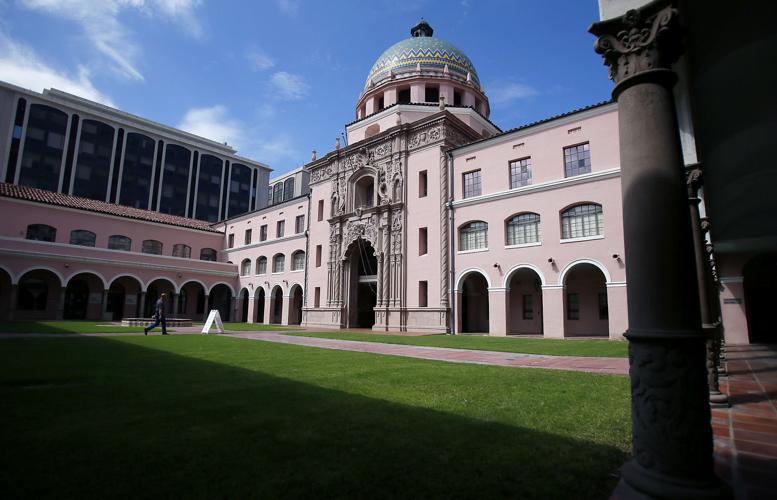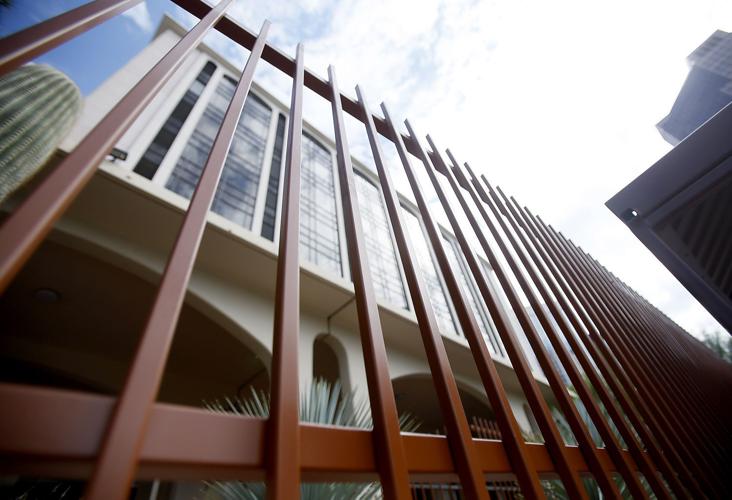Downtown Tucson’s historic, blue-domed courthouse is such an iconic image that it appears on Pima County’s letterhead and most of its other communications.
But it soon will be surrounded with a fence and locked up after hours as officials struggle to curb the ongoing problem of people sleeping and leaving human waste around downtown’s public buildings.
“It’s really a public health hazard,” Pima County Administrator Chuck Huckelberry said.
Pima County plans to spend more than $50,000 on fences and gates around the old courthouse and three county buildings facing Congress Street — Superior Court, administration and adult probation.
“This is a public building, it’s accessed by thousands of people, and it’s our obligation to make sure it’s a safe and healthy place,” Huckelberry said of the courthouse.
On Wednesday, crews began building steel fencing around the terraced planters that line the county complex. They started with the three buildings on Congress Street and will move to the old courthouse later this month.
The plan to fortify public places and limit accessibility, particularly at one of the region’s most identifiable structures, has raised some questions.
Altering its appearance could harm the historical significance of a building that has come to define regional architecture since it was built in the 1920s, said Demion Clinco, CEO of the Tucson Historic Preservation Foundation.
“The courthouse is one the most iconic buildings in all of downtown,” Clinco said.
HISTORICAL SIGNIFICANCE
Designed by Tucson architect Roy Place, the courthouse is an example of the Spanish Colonial Revival movement of the early 20th century.
Place incorporated elements of Moorish architecture in the courthouse as well in the open courtyard and mezzanine walkways.
The courthouse is a popular backdrop for wedding, quinceañera and other special-occasion photos. Many local law firms include its image in their advertising and marketing materials.
For local historian and tour guide Ken Scoville, the community’s connection with the building marks a rare example of reverence for the region’s history.
“Except for a few instances, Tucson has always wanted to seem modern and has not respected the past,” Scoville said.
When the county does install fences at the old courthouse, Scoville said he hopes it’s done in a style that matches the architecture of the building.
Huckelberry said the county intends to make the barriers as unobtrusive as possible.
“It will replicate the existing wrought iron,” he said.
Stair railings and some internal areas of the courthouse have wrought-iron fixtures, which the new gates and fences will resemble, he said.
The county intends to install a gate along the west opening of the courthouse, gates at either end of the covered sidewalk to the south and fences and gates across the entire main courtyard at the east side of the building.
In addition, an external stairwell also will be closed off with fencing.
The county plans to leave the property open during normal business hours and possibly into the evening.
Huckelberry said the county already has round-the-clock security at many buildings, so closing the gates at night and reopening them in the morning won’t be a problem.
CLOSING ‘SAFE PARK’
Closing a public space like the courthouse has become necessary because of what Huckelberry called “numerous and recurring” problems of human waste.
The amount of waste and other debris littering public spaces downtown intensified earlier this year when a group of activists and homeless people congregated in Vente de Agosto Park at Congress Street and Church Avenue.
The so-called “Safe Park” movement stemmed from a lawsuit homeless activists filed against the city after they were denied overnight camping permits for a city park at Speedway and Stone Avenue.
Groups of homeless people and activists eventually moved the perpetual protest to Vente de Agosto Park, and dozens took up residence in wooden boxes and tents along the sidewalks.
The city eventually dispersed the group and cited people for camping in the public right of way.
A police sting also netted several arrests for drug sales and possession in the park, including one of the protest organizers.
The city closed the park to the public shortly after, and it remains closed.
City officials said they don’t see the same issues with waste the county does.
“We did have issues at our parks and we closed Viente de Agosto Park,” Assistant City Manager Martha Durkin said.
Durkin said parks crews routinely clean downtown area parks and city properties.
While the city does not plan to fence off the park or other public spaces, no plans have been made to reopen Viente de Agosto.





